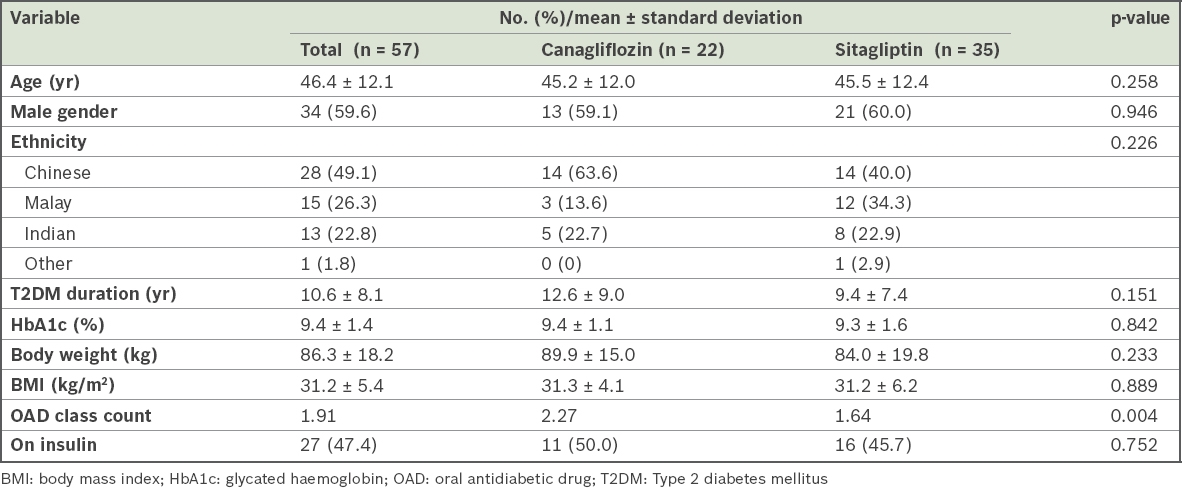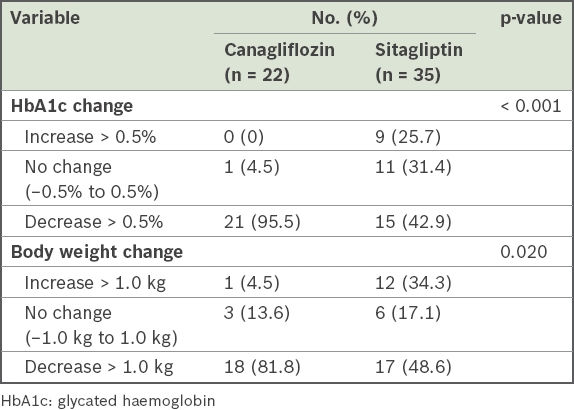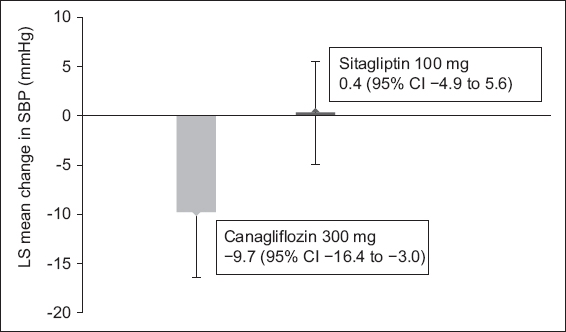Abstract
INTRODUCTION
We aimed to evaluate the effectiveness and safety of canagliflozin as compared to sitagliptin in a real-world setting among multiethnic patients with Type 2 diabetes mellitus (T2DM) in Singapore.
METHODS
This was a new-user, active-comparator, single-centre retrospective cohort study. Patients aged 18–69 years with T2DM and estimated glomerular filtration rate ≥ 60 mL/min/1.73 m2 were eligible for inclusion if they were initiated and maintained on a steady daily dose of canagliflozin 300 mg or sitagliptin 100 mg between 1 May and 31 December 2014, and followed up for 24 weeks.
RESULTS
In total, 57 patients (canagliflozin 300 mg, n = 22; sitagliptin 100 mg, n = 35) were included. The baseline patient characteristics in the two groups were similar, with overall mean glycated haemoglobin (HbA1c) of 9.4% ± 1.4%. The use of canagliflozin 300 mg was associated with greater reductions in HbA1c (least squares [LS] mean change −1.6% vs. −0.4%; p < 0.001), body weight (LS mean change −3.0 kg vs. 0.2 kg; p < 0.001) and systolic blood pressure (LS mean change: −9.7 mmHg vs. 0.4 mmHg; p < 0.001), as compared with sitagliptin 100 mg. About half of the patients on canagliflozin 300 mg reported mild osmotic diuresis-related side effects that did not lead to drug discontinuation.
CONCLUSION
Our findings suggest that canagliflozin was more effective than sitagliptin in reducing HbA1c, body weight and systolic blood pressure in patients with T2DM, although its use was associated with an increased incidence of mild osmotic diuresis-related side effects.
INTRODUCTION
Due to the progressive nature of disease in Type 2 diabetes mellitus (T2DM), patients often require a combination of oral antidiabetic drugs (OADs) and injectables to achieve and maintain optimal glycaemic control.(1,2) Weight gain and hypoglycaemia are common limiting side effects of many currently available OADs and insulins.(2) Owing to their weight-neutral effects and low risk of hypoglycaemia, dipeptidyl peptidase-4 (DPP-4) inhibitors have increasingly been positioned early in the treatment algorithms for patients with T2DM in recent years.(3) Various randomised trials have also shown that the use of DPP-4 inhibitors, including sitagliptin, does not increase cardiovascular risk, although an increased risk of heart failure was observed, particularly with the use of saxagliptin.(4,5)
Sodium glucose co-transporter 2 (SGLT2) inhibitors are another new class of OADs. They have been shown to promote weight loss and are associated with low risks of hypoglycaemia.(6) They lower blood glucose by inhibiting renal glucose reabsorption and increasing urinary glucose excretion.(7) Due to their distinct mechanism of action, SGLT2 inhibitors can provide additive glycaemic control across different stages of T2DM and with varying background antidiabetic therapy.(8) Many randomised clinical trials have shown that SGLT2 inhibitors consistently improve glycaemic control, blood pressure and body weight.(7) In the recently published EMPA-REG study, an SGLT2 inhibitor, empagliflozin, was shown to also reduce cardiovascular mortality in patients with T2DM who were at high risk for cardiovascular events.(9) In a more recent publication from the same study, it was reported that empagliflozin, when added to standard care, was associated with slower progression of kidney disease and lower rates of clinically relevant renal events than a placebo.(10)
Canagliflozin, the first United States Food and Drug Administration-approved SGLT2 inhibitor, was registered in Singapore in February 2014. Although it has been evaluated in a broad range of patients with T2DM in randomised clinical trial settings,(11-16) there is no data so far on the characteristics or outcomes of patients receiving canagliflozin in Singapore. The aim of this study was to evaluate the effectiveness and safety of canagliflozin as compared to sitagliptin, a commonly used DPP-4 inhibitor, in a real-world setting among multiethnic patients with T2DM in Singapore.
METHODS
This was a new-user, active-comparator, single-centre retrospective cohort study, conducted in August 2015 at the Diabetes Centre of Khoo Teck Puat Hospital, a tertiary-care hospital in Singapore. Patients aged 18–69 years with T2DM and estimated glomerular filtration rate (eGFR) ≥ 60 mL/min/1.73 m2 were eligible for inclusion if they were initiated and maintained on a steady daily dose of either canagliflozin 300 mg or sitagliptin 100 mg between 1 May 2014 and 31 December 2014, and subsequently completed 24 weeks of follow-up. Exclusion criteria for the study were: (a) history of Type 1 diabetes mellitus (T1DM; SGLT2 inhibitors have not been approved for use in patients with T1DM); and (b) eGFR < 60 mL/min/1.73 m2, which constitutes contraindication to the use of canagliflozin 300 mg, according to the manufacturer’s recommendations.
A list of the patients who were initiated and maintained on canagliflozin 300 mg or sitagliptin 100 mg daily during the study period was generated. Subsequently, the laboratory database and medical records of these patients were reviewed to confirm their eligibility and for the purpose of data collection. Both the baseline and follow-up glycated haemoglobin (HbA1c) results of eligible patients had to be available. All HbA1c readings in the study were measured by immunoassay using the Cobas system (Roche Diagnostics GmbH, Mannheim, Germany) standardised against the International Federation of Clinical Chemistry Working Group reference method for the measurement of HbA1c in human blood and traceable to the Diabetes Control and Complications Trial/National Glycohemoglobin Standardization Program by calculation. HbA1c analysis performed at the last visit before the initiation of the study drug was considered the baseline, while HbA1c measured at the last follow-up visit during the 24-week period was considered the follow-up reading. Other laboratory results were recorded as baseline measures if they had been performed within six months prior to the initiation of the study drug, and the latest results available within the 24-week follow-up period were considered follow-up measures.
The study protocol was reviewed and approved by the institutional review board. Informed consent was waived for study patients, as there were no foreseen significant risks posed to the patients by being included in this retrospective medical record review study.
The primary endpoint of the study, which points to the effectiveness of the study drug, was change in HbA1c from baseline at the end of the 24-week follow-up. Secondary endpoints included changes in baseline body weight, systolic blood pressure, low-density lipoprotein (LDL)-cholesterol and urinary albumin-creatinine ratio by the end of the 24-week follow-up period. HbA1c change > 0.5% and body weight change > 1.0 kg from baseline were considered clinically significant in the study. The proportions of patients with significant changes in HbA1c and body weight in the two study groups were compared.
Data for safety evaluation was collected based on prespecified types of adverse events (AEs), including genital mycotic infections, urinary tract infections, side effects related to volume loss or osmotic diuresis, gastrointestinal side effects, skin reactions and hypoglycaemia. The incidence of hypoglycaemia in the study was assessed by collating the attending physician’s entries of hypoglycaemic episodes, as documented in the medical records.
The primary analysis in the study was to compare the effectiveness in HbA1c reduction from baseline between the canagliflozin 300 mg group and sitagliptin 100 mg group. The study was powered at 80%, with a significance level of 5%. It was estimated that 17 patients in each treatment group would be needed to demonstrate a between-group mean difference of 0.5% in HbA1c reduction, assuming a common standard deviation of 0.5% with respect to change in HbA1c.
Statistical analysis was performed using IBM SPSS Statistics version 22 (IBM Corp, Armonk, NY, USA). Baseline characteristics of patients receiving canagliflozin 300 mg versus sitagliptin 100 mg were compared using t-test or chi-square test, as appropriate. We also compared the least squares (LS) mean change in key measures between the two groups, with two-sided 95% confidence intervals. Chi-square test was used to compare the proportion of patients with AEs and OAD class count change between the two groups. OAD count in the present study referred to the total number of OAD classes a patient was on. All statistical tests used in the study were two-sided and considered significant at p < 0.05.
RESULTS
A total of 57 patients met the study criteria and were included in the study – 22 patients were from the canagliflozin 300 mg group and 35 patients from the sitagliptin 100 mg group. Baseline characteristics of patients in the two treatment groups were generally similar (
Table I
Baseline characteristics of patients in the canagliflozin 300 mg and sitagliptin 100 mg groups.

Baseline mean count of OAD classes in the canagliflozin 300 mg group was significantly higher than in the sitagliptin 100 mg group (2.27 vs. 1.64; p = 0.004). At baseline, 50.0% of patients from the canagliflozin 300 mg group and 45.7% from the sitagliptin 100 mg group were on insulin therapy in addition to OAD treatment (p = 0.752).
At 24 weeks of follow-up, the use of canagliflozin 300 mg was associated with greater reduction in HbA1c from baseline when compared with sitagliptin 100 mg (LS mean change: −1.6% vs. −0.4%; p < 0.001;
Table II
Changes in HbA1c and body weight among patients in the canagliflozin 300 mg and sitagliptin 100 mg groups.

Fig. 1
Least squares (LS) mean change graph shows change in glycated haemoglobin (HbA1c) in the canagliflozin 300 mg and sitagliptin 100 mg groups from baseline (p < 0.001). CI: confidence interval.

Fig. 2
Charts show the distribution of patients according to glycated haemoglobin A1c (HbA1c) at baseline and 24 weeks of follow-up in the (a) canagliflozin 300 mg and (b) sitagliptin 100 mg groups.

Besides improvements in HbA1c, the use of canagliflozin 300 mg was also associated with a significant reduction in body weight at 24 weeks of follow-up, whereas a slight weight increase was observed in patients on sitagliptin 100 mg (LS mean change: −3.0 kg vs. 0.2 kg; p < 0.001;
Fig. 3
Least squares (LS) mean change graph shows change in body weight in the canagliflozin 300 mg and sitagliptin 100 mg groups from baseline (p < 0.001). CI: confidence interval

Systolic blood pressure in the canagliflozin 300 mg group was significantly lower at the 24-week follow-up when compared with baseline, while no meaningful change was seen in the sitagliptin 100 mg group (LS mean change: −9.7 mmHg vs. 0.4 mmHg; p < 0.001;
Fig. 4
Least squares (LS) mean change graph shows change in systolic blood pressure (SBP) in the canagliflozin 300 mg and sitagliptin 100 mg groups from baseline (p < 0.001). CI: confidence interval.

Of note, despite the significantly greater reductions in HbA1c and body weight in the canagliflozin 300 mg group, more patients from this group had decreased OAD class counts at the 24-week follow-up when compared with the sitagliptin 100 mg group (40.9% vs. 22.9%; p = 0.219;
Table III
Changes in OAD count from baseline among patients in the canagliflozin 300 mg and sitagliptin 100 mg groups.

There were no serious AEs leading to discontinuation of the study drug in both groups. However, five patients from the sitagliptin group discontinued the treatment due to insufficient HbA1c reduction and two patients discontinued canagliflozin due to concerns about high cost. About half of the patients on canagliflozin 300 mg reported mild osmotic diuresis-related side effects (
Table IV
Summary of overall safety and selected adverse events (AEs) among patients in the canagliflozin 300 mg and sitagliptin 100 mg groups.

Fig. 5
Least squares (LS) mean change graph shows change in estimated glomerular filtration rate (eGFR) in the canagliflozin 300 mg and sitagliptin 100 mg groups from baseline (p = 0.639). CI: confidence interval

DISCUSSION
To the best of our knowledge, this is the first study assessing the use of canagliflozin in a multiethnic patient population in a real-world setting, after it was made available in Singapore. We used a new-user, active-comparator study design and selected sitagliptin as the active comparator, as these two agents represent the pharmacological classes that may be considered the next possible alternative for initiation when first- or second-line OADs fail to achieve or maintain optimal HbA1c.
Our study enrolled patients with T2DM who had a wide range of baseline HbA1c values, although most of them had baseline HbA1c ≥ 9% despite being on multiple antidiabetic agents. Compared with sitagliptin 100 mg, canagliflozin 300 mg provided significantly greater reductions in HbA1c, body weight and systolic blood pressure. The observed differences in effect between the two drugs in our patients were greater than what was reported in previous randomised trials.(14,18) Interestingly, these results were achieved with relatively greater reduction in OAD use in the canagliflozin 300 mg group, although the difference did not reach statistical significance. Treatment with SGLT2 inhibitors has been shown to be associated with a slight increase in LDL-cholesterol in randomised clinical trials.(9,14) In our study, with a relatively small sample size, there was no significant change in LDL-cholesterol from baseline in the canagliflozin 300 mg group.
In this study, canagliflozin treatment was associated with a higher incidence of genital mycotic infections, as well as AEs related to osmotic diuresis and volume loss. However, canagliflozin was generally well tolerated and our patients had no AEs leading to discontinuation of the drug. The incidence of documented hypoglycaemia was also similar in both groups, and all patients who had reported hypoglycaemic episodes were on insulin therapy and/or high-dose sulfonylureas. The canagliflozin 300 mg group was noted to have greater reduction in eGFR numerically than the sitagliptin 100 mg group in our study (p = 0.639). However, recent studies have suggested that initial renal function decline following canagliflozin treatment could be transient, as it tended to plateau from about 26 weeks onward.(19) Recent renal outcome data from the EMPA-REG study also showed that despite the initial decrease, eGFR remained stable for patients on empagliflozin, while patients on a placebo experienced a gradual but persistent decline in eGFR.(10)
DPP-4 inhibitors are known to be efficacious and to date, have not been associated with a serious AE profile.(20) Our short-term, real-world study showed that sitagliptin did demonstrate remarkably few AEs, even if it was less effective in improving glycaemia, and in reducing body weight and systolic blood pressure compared to canagliflozin. Sitagliptin has been shown to not cause hypoglycaemia and weight gain or increase cardiovascular risk.(4) DPP-4 inhibitors can also be used in renal failure, although some agents need dose adjustment,(21) and are probably safe even in older patients with T2DM.(22)
This study was not without limitations. Although the sample size and follow-up period in our study was adequate for the aim of making a rapid real-world assessment of the efficacy and safety of canagliflozin in the local context, studies with a larger sample size and longer duration of follow-up would allow for better observation of durability of effect on glycaemia and renal function trend, as well as potential side effects, including the recently discussed euglycaemic diabetic ketoacidosis among patients who use SGLT2 inhibitors.(23) Other limitations of the study were related to its retrospective nature and real-world setting. We could not exclude the possibility that the higher number of reported AEs associated with the use of canagliflozin was because patients treated with canagliflozin were monitored more closely for AEs by the attending physicians, since it was a newly registered drug at the time. Although review of medical records indicated that none of the patients in the present study had autoimmune/infectious diseases or were on steroids during the study period, other confounding factors, such as physical activities, dietary pattern and medication change (other than those related to glycaemic management), were not controlled for in the study.
In summary, the results of this study will help clinicians better understand the relative effect and short-term outcomes of patients with T2DM taking canagliflozin as part of their treatment regimen in the real world. However, clinicians will have to consider individual characteristics, needs and tolerance when selecting a pharmacological agent for each patient. It is hoped that this study, with its findings on the use of canagliflozin and sitagliptin as a second- and/or third-line antidiabetic agent in the real-world setting, will add to the body of knowledge and guide clinicians to individualise treatment to achieve the best possible outcome for each patient.


